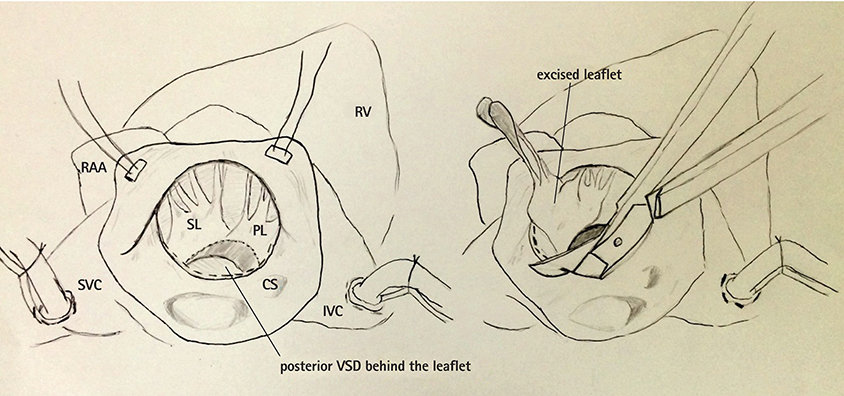Korean Circ J.
2016 Jan;46(1):107-110. 10.4070/kcj.2016.46.1.107.
Transatrial Approach for the Repair of the Posterior Post-Infarct Ventricular Septal Rupture
- Affiliations
-
- 1Department of Thoracic and Cardiovascular Surgery Kosin University Gospel Hospital, Busan, Korea.
- 2Department of Thoracic and Cardiovascular Surgery, Samsung Medical Center, Sunkyunkwan University School of Medicine, Seoul, Korea. wooksungkim@yahoo.com
- KMID: 2223777
- DOI: http://doi.org/10.4070/kcj.2016.46.1.107
Abstract
- Ventricular septal rupture (VSR) is a disastrous mechanical complication of myocardial infarction. Although several surgical interventions have been developed, mortality due to surgical management remains high, especially in the case of posterior VSR. We report a successful case of repair of posterior VSR using an alternative transatrial approach to avoid the complications related to ventricular incision.
Figure
Reference
-
1. Raddford MJ, Johnson RA, Daggett WM Jr, et al. Ventricular septal rupture: a review of clinical and physiological features and an analysis of survival. Circulation. 1981; 64:545–553.2. Muehrcke DD, Daggett WM. Current surgical approach to acute ventricular septal rupture. Adv Card Surg. 1995; 6:69–90.3. Coskun KO, Coskun ST, Popov AF, et al. Experiences with surgical treatment of ventricle septal defect as a post infarction complication. J Cardiothorac Surg. 2009; 4:3.4. Komeda M, Fremes SE, David TE. Surgical repair of postinfarction ventricular septal defect. Circulation. 1990; 82:5 Suppl. IV243–IV247.5. Kirklin JW, Barratt-Boyes BG. Postinfarction ventricular septal defect. Cardiac surgery. New York: Churchill Livingstone;1993. p. 403–413.6. Filgueira JL, Battistessa SA, Estable H, Lorenzo A, Cassinelli M, Scola R. Delayed repair of an acquired posteior septal defect through a right atrial apporoach. Ann Thorac Surg. 1986; 42:208–209.7. Massetti M, Babatasi G, Le Page O, Bhoyroo S, Saloux E, Khayat A. Postinfarction ventricular septal rupture: early repair through the right atrial approach. J Thorac Cardiovasc Surg. 2000; 119(4 Pt 1):784–789.8. Lee WY, Kim SJ, Kim KI, et al. Transatrial repair of post-infarction posterior ventricular septal rupture. Korean J Thorac Cardiovasc Surg. 2011; 44:186–188.
- Full Text Links
- Actions
-
Cited
- CITED
-
- Close
- Share
- Similar articles
-
- Transatrial Repair of Post-infarction Posterior Ventricular Septal Rupture
- Mitral Regurgitation due to Recurrent Septal Rupture after Repair of a Postinfarction Posterior Ventricular Septal Defect: A Case Report
- Reoperation of Postinfarction VSD
- Post-Infarction Ventricular Septal Rupture: 10 Years of Experience
- One Stage Repair of Traumatic Ventricular Septal Defect and Mitral Regurgitation





